Magnetic separation is a physical separation of particles based on the magnetic property of the mineral particles. The property of a material which determines its response to a magnetic field is the magnetic susceptibility.
1 MAGNETISM
Molecules of all substances are basically magnets in themselves, each having a north and south pole. In a magnet, these molecular magnets lie in line so that north poles of molecular magnets are on one end and south poles on the other. Thus, two definite poles N and S are developed at the ends. Magnetic field (or force) of a magnet is the surrounding space through which its influence extends.For ferro-magnetic substances, such as iron, nickel, cobalt and alloys such as nickel-iron, and cobalt-iron, relative permeability is much greater than unity whereas for para-magnetic substances, such as aluminium, relative permeability is slightly greater than unity. For diamagnetic materials such as bismuth, the relative permeabiity is less than unity.Magnetic flux density is the magnetic force at a point inside a magnetic material and is the resultant of the externally impressed magnetic field and the force due to the induced poles at the ends of the rod.An infinite number of combinations of field and gradient can be used to generate required lifting force. Production of a high field gradient as well as high intensity is therefore an important aspect in designing a magnetic separator.
2 ELECTRO-MAGNETISM
Magnetic field can be created by electric current. When an electric current (I) flows through a conductor, magnetic field is set up all along the length of the conductor. The magnetic lines of force are circular in a plane perpendicular to the current (Figure.1). The magnetic field near the conductor is stronger and becomes weaker as the distance increases from the conductor. The magnetic field becomes stronger if the current is increased and vice-versa. The direction of the field is reversed if the current is reversed.

Figure 1 Magnetic lines of force.
Solenoids are of two types (1) Iron-cored solenoid and (2) Air-cored solenoid. In the iron-cored solenoid (Figure2 (a)), the set of circular coils are wound on an iron bar. In the air-cored solenoid (Figure 2 (b)), there is air inside the coils.
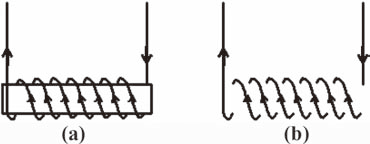
Figure 2 Types of solenoid.
Bars of soft wrought iron, soft steel or cast iron are magnetized by electric currents through the insulated copper or aluminum wire windings around the iron bars. These iron bars form electromagnets as long as the current flows through the windings. The poles of an electromagnet may be reversed by simply reversing the direction of flow of the electric current. The magnetism, or magnetic field, can be obtained of different intensities ranging from indefinitely weak to a certain maximum of strength. The intensity of the magnetic field depends on the size of the magnet, the form of it, the distance between the body to be attracted and the magnet, and the number of ampere turns in the magnet coil, that is, the product of the amperes of current flowing in the coil (I) times the number of turns around the core (N). One important characteristic of magnetic flux is that each line is a closed loop. The complete closed path followed by group of lines of magnetic flux is known as magnetic circuit. Consider an iron ring wound with a number of turns as shown in Figure3. When a current is passed through the winding, magnetic lines of force are set up in the ring. The path of these lines is called the magnetic circuit.
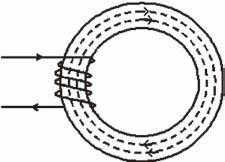
Figure 3 Magnetic circuit
The practical magnetic circuits have mostly air gap i.e. magnetic flux is intended to pass through a certain distance in air as shown in Figure 4. Flux through air gap is called useful flux because it is only this flux which can be utilized for various purposes. It is, therefore, desired that total flux produced should pass through air gap. However, as air is not a perfect magnetic insulator, therefore, a part of the total flux returns by such paths as ‘a’ and ‘b’ and is called leakage flux. It is so called because it does not pass through the air gap rather it follows a leaking path.In an electromagnet, the induction for a current of given intensity decreases rapidly with an increase in the air gap and the force of attraction decreases even more rapidly with an increase in the air gap. To get a suitable field at the lowest operating cost, it is recommended to reduce the air gap to a minimum, to reduce the reluctance to a minimum by using a highly permeable core, a large cross section and a short length and to use many turns and a small current.
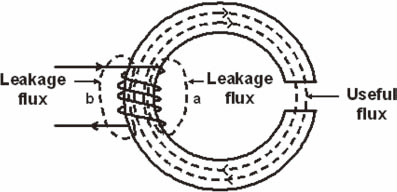
Figure 4 Magnetic circuit with air gap.
3 TYPES OF MINERALS
Based on magnetic susceptibility, minerals are classified into three broad groups as Ferromagnetic, Paramagnetic and Diamagnetic.Ferromagnetic minerals have a very high susceptibility to magnetic forces and retain some magnetism when removed from the magnetic field. They are strongly attracted by the magnetic field. They can be concentrated by low-intensity magnetic separators. The principal ferromagnetic mineral separated is magnetite (Fe3O4).Paramagnetic minerals are weakly attracted by magnetic field. They can be concentrated by high-intensity magnetic separators. Examples of paramagnetic minerals are ilmenite (FeOTiO2), rutile (TiO2), wolframite ((Fe,Mn)WO4), hematite (Fe2O3), siderite (FeCO3), chromite (FeOCr2O3), pyrrhotite (FeS) and manganese minerals. Hematite and siderite can be roasted to produce magnetite and can be separated by low-intensity magnetic separators.Diamagnetic minerals are repelled along the lines of magnetic force to a point where the field intensity is smaller. The forces involved here are very small. They cannot be concentrated magnetically. Examples are quartz (SiO2) and feldspar (KAlSi3O8 or NaAlSi3O8).
4 MAGNETIC SEPARATORS
The machines used for magnetic separation are called magnetic separators. The principle operation of a magnetic separator is:When a stream of ore particles is continuously passed through a field of magneticforce, the magnetic particles are attracted towards the source of magnetic force while the non-magnetics travel unaffected.Magnetic separation, in an industry, is achieved by simultaneously applying a magnetic force on all particles of an ore which acts on magnetic particles and a combination of forces which acts in a different direction and affects both magnetic and nonmagnetic particles. The most commonly applied nonmagnetic forces are gravitational, centrifugal, and fluid drag. Other forces which usually enter in an incidental manner are frictional, inertial and attractive or repulsive inter-particle forces.These forces depend on both the nature of the feed material and the character of the separator. The nature of the feed material includes its size distribution, magnetic susceptibility and other physical and chemical properties that may effects the various forces involved.Magnets used in magnetic separators are of two types; Permanent magnets and Electromagnets. Permanent magnets are magnetized steel bars which retain magnetism indefinitely. Special-permanent magnet alloys produce a magnetic field at a constant level indefinitely after initial charging. The newer ceramic permanent magnets in the form of barium and strontium ferrites, and rare-earth-cobalt permanent magnet alloys are also being in use. Bars of soft wrought iron, soft steel or cast iron are magnetized by electric currents through the insulated copper or aluminum wire windings around the iron bars. These iron bars form electromagnets as long as the current flows through the windings.Magnetic separators, can be classified into two groups based on their function:
1 Tramp iron magnetic separators are those used to remove tramp iron and protect the handling and processing equipment.
2 Concentrators are those used to separate the bulk of magnetic materials from a stream of ore. Magnetic separators that are used to remove small quantities of deleterious magnetic material from a product (e.g. from china clay) are termed as purifiers. The concentrators that remove magnetic material from a product and return to the process are termed as reclaimers (e.g. separation of medium particles such as magnetite, ferrosilicon etc. in Heavy Medium Separation process).
4.1 Tramp iron magnetic separators
Iron coarser than 3 mm is usually called tramp iron. Most commonly applied magnetic separators for removing tramp iron are suspended magnets, magnetic pulleys, and grate magnets. Suspended magnets are fixed position electromagnets of rectangular shape and installed over a conveyor belt or head pulley (Figure5). Tramp iron attracted by the magnet is periodically removed. Cross-belt models (Figure 5) are used when the continuous removal of tramp iron is required. In a magnetic pulley, magnets are located within the head pulley of a belt conveyor (Figure 5). The tramp iron is attracted by the magnetic pulley and carried to distant place and discharged when the material comes out of magnetic field while the required material is discharged at the same place. Grate magnet consists of a series of magnetized bars (Figure5) and is used to remove fine iron as well as tramp iron. Feed is usually vertical through the grate. These magnets must be periodically cleaned.

(a) Suspended Magnet (b) Cross belt (c) Magnetic (d) Grate magnet Head Pulley
Figure 5 Tramp iron magnetic separators
4.2 Concentrators
These magnetic separators are classified into dry and wet separators which may further classified into low- and high-intensity separators. Wet separators are generally used for the particles of below 0.5 cm size.
Drum separators are common low-intensity dry magnetic separators. These are applied in concentration and purification where magnetic particles to be removed are large in size and the magnetic responsiveness of the magnetic particles is high. This operation of picking up strongly magnetic particles at a coarser size is called cobbing operation. Drum separators consist of a rotating non-magnetic drum containing either permanent or electromagnets. Magnetic particles are attracted by the magnets, pinned to the drum, conveyed out of the field and discharged while the nonmagnetic particles are discharged unaffected. The magnetic drum is normally fed at the top vertical center, but, with appropriate magnet positioning, it can be fed at any convenient point or even front-fed or underfed (Figure6).
Magnetic drum is also used for tramp iron removal. Magnetic head pulley and grate magnet used for tramp iron removal are also used as concentrators. Grate magnet is especially useful for purification of the product when it contains small amounts of unwanted magnetic particles.
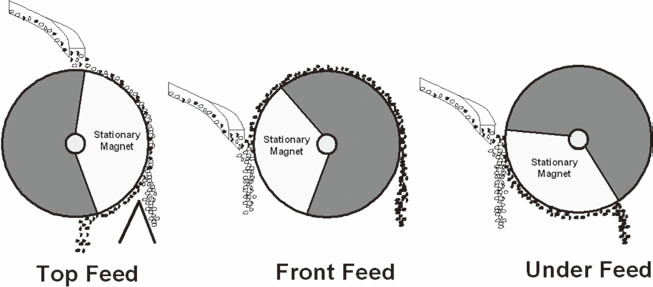
Figure6 Dry magnetic drum separators
Induced roll separator and cross-belt separator are the two high intensity dry magnetic separators. Induced roll separator (Figure7) consists of a horseshoe magnet faced by an iron bridge bar or keeper and of two rolls, one opposite each pole. The magnetic circuit is completely in iron except for the very small clearance between the rolls and the bridge bar and for the gaps between the rolls and primary poles of horseshoe magnet. The rolls consist of alternate laminae of permeable and impermeable material with a serrated profile and produce the high field intensity and gradient required. The field strengths of up to 2.27 T are attainable in the gap between feed pole and roll. Non-magnetic particles are thrown off the roll into the tailings compartment, whereas magnetics are gripped, carried out of the influence of the field and discharged. The gap between the feed pole and rotor is decreased from pole to pole successively to separate weaker magnetic products.Cross-belt separator consists of two or more horseshoe electromagnets arranged with poles of opposite sign in apposition, one electromagnet being below and the other above the feed belt. The poles of the upper magnets are wedge-shaped while the lower poles are flat. This concentrates the field and attracts the paramagnetic minerals toward the wedge-shaped poles. Dry material is fed in a uniform layer on to the conveyor belt and is carried between the poles. The cross-belt prevents the magnetic particles from adhering to the poles and carries them out of the field. Disc separator is the modification of the cross belt separator wherein discs revolve above a conveyor belt and are magnetized by induction from powerful stationary electromagnets placed below the belt. A disc separator permits a much smaller air gap and provides a greater degree of selectivity in separating the minerals differing in their magnetic susceptibility slightly.
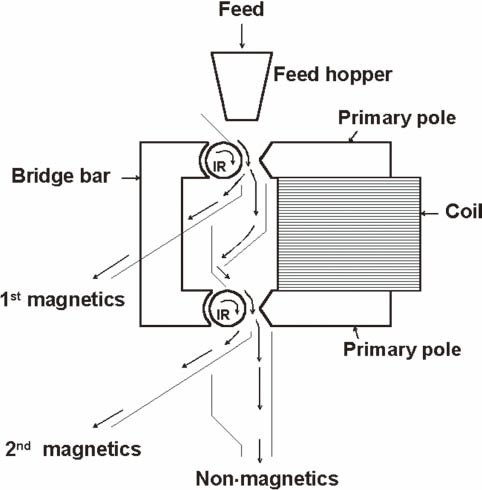
Figure7 Induced roll magnetic separator.
4.2.2 Wet magnetic separators
Drum separators are most common low-intensity wet magnetic separators. They consist of a rotating non-magnetic drum containing three to six stationary magnets, either permanent or electromagnets, of alternating polarity. Magnetic particles are lifted by the magnets and pinned to the drum and are conveyed out of the field leaving the gangue particles. Water is introduced into the machine to provide a current which keeps the pulp in suspension. Three types of drum separators namely concurrent type, counter-rotation type and counter-current type (Figure 8) are in use. Concurrent type separators are used when clean concentrate is required from relatively coarse material such as heavy medium recovery systems. Counter-rotation type separators are used in the roughing operation of larger tonnages. Counter-current type separators are designed for finishing operation on relatively fine material.
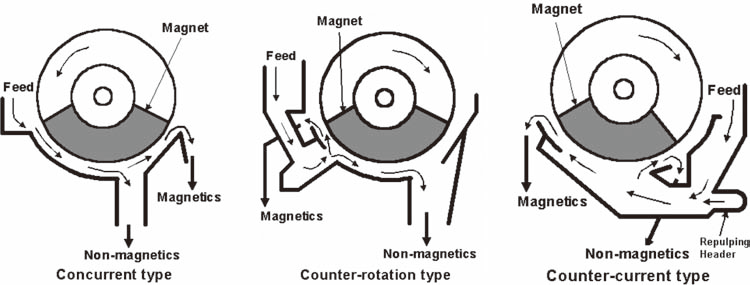
Figure.8 Low-intensity wet drum magnetic separators.
The Readings are wet high intensity magnetic separators (WHIMS). The unit (Figure9) consists of a rotating carousel, which has vertically inclined salient plates through which feed slurry is passed. As the carousel rotates, it passes through fields of magnetic influence generated by surrounding electromagnets, followed by fields of no magnetic influence. The magnetic grains are initially held up in the plates while the non magnetic grains are washed through into a launder below. When the plates are in the non magnetic field the magnetic grains are washed off into a separate launder below.
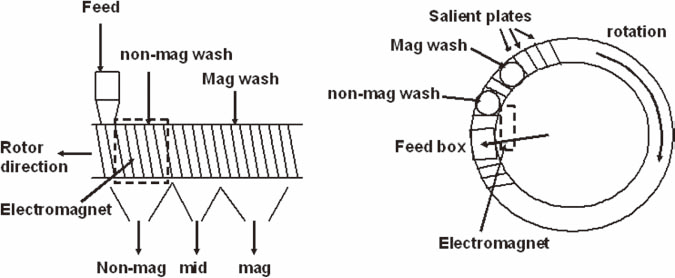
Figure 9 Wet high-intensity magnetic separator.
In order to attract and hold paramagnetic particles, both high magnetic field and a high field gradient are required. These high gradient magnetic separators (HGMS) produce field strength of about 2 T. In HGMS, the slurry is passed through a container where it is subjected to a high-intensity, high gradient magnetic field. The container is packed with a capture matrix made of stainless steel wool. In the presence of magnetic field, paramagnetic particles become magnetized and are trapped in the matrix while the unaffected non-magnetic particles pass through the container. When the matrix is loaded to its magnetic capacity, the slurry feed is stopped and the electric power is cut off. The matrix is then backwashed to remove magnetic particles. Afterwards, the feed and the power are resumed and the entire process is repeated. In the continuous separator, the capture matrix is a continuous, segmented metal belt. The slurry is introduced while capture matrix passes through the magnetic section of the separator. The magnetized particles are trapped in the capture matrix. The belt then travels in to the washing section to wash magnetic particles trapped on the belt. The cleaned belt section then returns for the entire process to be repeated.
Related you may like:
---Crushing and screening automatic control
---Grinding and classifing automatic control
---General layout of mineral processing plant
---Dewatering workshop arrangement
---Gravity separation workshop arrangement
---Magnetic separation workshop arrangement
---Ore washing process and workshop configuration
---Crushing and screening plant layout design
---Ball mill and flotation machine workshop arrangement
---The new way mineral processing of Graphite ore
---Structure and features of vibrating screen
---Structure of overflow ball mill and rod mill
---Grinding ball mill structure
---beneficiation experiment- ore sampling
---Mineral magnetic separation